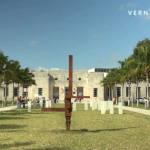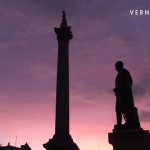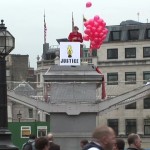Antony Gormley currently is in the media because of his work One and Other, a work conceived for the Fourth Plinth on the northwest corner of Trafalgar Square. Antony Gormley invited 2,400 members of the public to spend one hour on the plinth. The project runs 100 consecutive days (until October 14, 2009).
Running concurrently, Kunsthaus Bregenz dedicates Antony Gormley a major solo exhibition. The exhibition at Kunsthaus Bregenz, Austria, is a major solo show that presents four key bodies of work: Body and Fruit, Critial Mass, Allotment II and Clearing V. “Embedded in the context of Peter Zumthor’s architecture, they challenge the fine line in the human psyche that marks the mental balance between asserting oneself as an individual and blending into the masses.” (Excerpt from the press release).
Antony Gormley at Kunsthaus Bregenz, Austria. Opening reception, July 11, 2009.
> Right-click (Mac: ctrl-click) this link to download Quicktime video file.
Antony Gormley currently is in the media because of his work One and Other, an invitation to stand on the Fourth Plinth. The fourth plinth on the northwest corner of Trafalgar Square in London, designed by Sir Charles Barry and built in 1841, was intended to hold a statue of William IV, but remained empty due to insufficient funds. Later, agreement could not be reached over which monarch or military hero to place there. In 1999, the Royal Society of Arts (RSA) conceived the Fourth Plinth Project, which temporarily occupied the plinth with a succession of works commissioned from three contemporary artists, Mark Wallinger, Bill Woodrow, and Rachel Whiteread. After several years in which the plinth stood empty, the new Greater London Authority assumed responsibility for the fourth plinth and started its own series of changing exhibitions: Marc Quinn (2005), Thomas Schütte (2007), and now Antony Gormley (July 6 – October 14, 2009). For a hundred consecutive days, 2,400 selected members of the public will each spend one hour on the plinth. They will be allowed to do anything they wish to and be able to take anything with them, provided they can carry it unaided. Volunteers were invited to apply through the website www.oneandother.co.uk, and were chosen so that ethnic minorities and people from all parts of Britain were represented. There will be a live feed of the plinth on the Internet sponsored by TV channel Sky Arts.
The exhibition at Kunsthaus Bregenz, Austria, is a major solo show that presents four key bodies of work: Body and Fruit, Critial Mass, Allotment II and Clearing. “Embedded in the context of Peter Zumthor’s architecture, they challenge the fine line in the human psyche that marks the mental balance between asserting oneself as an individual and blending into the masses.”
On the ground floor, the exhibition starts with seven tons of rusting iron that make up Body and Fruit (1991/93). Body and Fruit are two of Gormley’s Expansion Works, made between 1990 and 1994. The skin, or sensory limit of the body, is extended through the application of consistent spars radiating from nodal points at the extremities of the body. These are linked together at their outer ends to form a continuous surface. The large heavy objects hang just a few centimeters from the floor.
The show continues with a labyrinth of concrete: Allotment II (1996), 300 life-size elements made of reinforced concrete derived from the dimensions of local inhabitants of Malmö. From these detailed measurements Antony Gormley constructed three hundred reenforced concrete cases (each 5 cm thick), translating the individual shape of the respective person’s body into the form of a modernist bunker. All body openings (mouth, ears, anus and genitalia) are transcribed into the concrete box according to the individual’s measurements. On the second floor the visitor is confronted with Clearing V (2009), an seemingly endless metal line of approximately 10 km of 12.7 mm x 12.7 mm aluminum tube that fills the whole space from floor to ceiling and wall to wall. And finally there’s Critical Mass II (1995), an installation of sixty figures cast in iron from moulds taken of his body.
“Allotment and Critical Mass approach the collective body in dialectically different ways: body-forms falling or dropped, forming a chaotic and abject field, and void concrete cases arranged in a strict city grid. In contrast to these opposed masses and spaces Clearing creates a dynamic field: a drawing that acts like a web or nest to entrap and entrance the viewer, confusing and contradicting the clearly defined volumes of Zumthor’s architecture while remaining open to atmospheric changes of light. This sensation is contrasted by the results of a contained explosion where the physical meets the incommensurable in the seven tonnes of rusting iron that make up Body and Fruit.” (excerpt from the press release).






